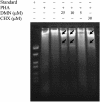Demethylnobiletin inhibits delayed-type hypersensitivity reactions, human lymphocyte proliferation and cytokine production
- PMID: 17934513
- PMCID: PMC2189996
- DOI: 10.1038/sj.bjp.0707500
Demethylnobiletin inhibits delayed-type hypersensitivity reactions, human lymphocyte proliferation and cytokine production
Abstract
Background and purpose: Our aim was to examine the effect of demethylnobiletin on various experimental models of delayed-type hypersensitivity (DTH) reactions and to determine its influence on the mediators and enzymes involved in these reactions.
Experimental approach: DTH was induced in mice by oxazolone, dinitrofluorobenzene (DNFB) and sheep red blood cells (SRBC). The effect of demethylnobiletin on the ensuing DTH was studied, especially in relation to oedema formation, cell infiltration and tissue damage. Its activity on different mediators implicated in DTH reactions was also determined and its effect on nitric oxide synthase (NOS)-2 analysed. Finally, its influence on T lymphocyte proliferation, apoptosis and caspase 3 activity was tested.
Key results: DTH reactions were all reduced by demethylnobiletin. The experimental results suggest that the compound may act by reducing cell infiltration and by suppressing mediators such as interleukin-2 (IC50=1.63 microM), interleukin-4 (IC50=2.76 microM), tumour necrosis factor-alpha (IC50=0.66 microM), interferon-gamma (IC50=1.35 microM), and interleukin-1 beta (46% at 2.5 microM) and by concomitantly increasing the production of the anti-inflammatory cytokine, interleukin-10. In addition, while demethylnobiletin affected nitric oxide production, it did not modify NOS-2 expression. Finally, demethylnobiletin inhibited proliferation of T cells and induced their apoptosis.
Conclusions and implications: Demethylnobiletin decreased DTH reactions induced by various agents. This finding, along with the fact that the compound has a low toxicity and exhibits several other interesting properties, could pave the way for other structurally related citroflavonoids to be used as pharmacological agents in complementary therapies.
Figures





References
-
- Bas E, Recio MC, Giner RM, Máñez S, Cerdá-Nicolás M, Ríos JL. Anti-inflammatory activity of 5-O-demethylnobiletin, a polymethoxyflavone isolated from Sideritis tragoriganum. Planta Med. 2006;72:136–142. - PubMed
-
- Bruch-Gerharz D, Ruzicka T, Kolb-Bachofen V. Nitric oxide in human skin: current status and future prospects. J Invest Dermatol. 1998;110:1–7. - PubMed
-
- Chi YS, Jong HG, Son KH, Chang HW, Kang SS, Kim HP. Effects of naturally occurring prenylated flavonoids on enzymes metabolizing arachidonic acid: cyclooxygenases and lipoxygenases. Biochem Pharmacol. 2001;62:1185–1191. - PubMed
-
- Delaney B, Phillips K, Buswell D, Mowry B, Nickels D, Cox D, et al. Immunotoxicity of a standardized citrus polymethoxylated flavone extract. Food Chem Toxicol. 2001;39:1087–1094. - PubMed
Publication types
MeSH terms
Substances
LinkOut - more resources
Full Text Sources
Research Materials

